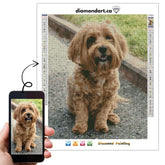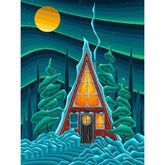DiamondArt.ca's Diamond Painting Dictionary
Diamond painting has developed its own collection of common terms and abbreviations throughout the years. As a beginner, you may not understand the terms and abbreviations you're seeing online when you search for diamond paintings or following diamond painting groups on social media. If you're wondering what DMC codes are, what a WIP is, or what the difference between drills and crystals are, we've got you covered! You can reference our dictionary any time - and let us know if there are some terms that have not been included in this list!
FIRST THINGS FIRST
There are a few terms you'll want to be familiar with when you begin your diamond painting journey.
Canvas: Every diamond painting is printed on a canvas. Yes - like a canvas for painting! The picture (with symbols) is printed onto a canvas and a sticky glue is poured on top, allowing the diamonds to be applied.
DP: The acronym used to shorten the term "diamond painting."
Drills: The sparkly diamonds in each diamond painting kit are often referred to as drills.
Drill Pen: A drill pen is the tool used to pick up diamonds and place them on the canvas. Every DiamondArt.ca diamond painting kit comes with a pen. We also sell fancy, more comfortable pens as well!
Full Drill Canvas: A full-drill canvas is a diamond painting where the entire canvas is covered in diamonds when the piece is complete.
Partial Drill Canvas: A partial drill canvas is only partially covered in diamonds when the piece is complete. A high-resolution picture is printed onto the canvas and diamonds are added as an accent.
Kit: A diamond art kit refers to the entire package that arrives with each DiamondArt.ca diamond painting. Each kit includes a canvas, drills, wax and a diamond painting pen. These are all the tools you need to complete the artwork!
Round Drill: Diamonds that are round in shape are referred to as round drills. Most beginners prefer round drills since they are a bit easier to work with.
Square Drill: Diamonds that are square in shape are referred to as square drills. Some diamond painters prefer square drills since they don't leave the tiny space between each placed drill that round diamonds do.
Tray: Each diamond painting kit includes a tray, a container to hold your drills. Diamond painting trays are designed with grooves to hold diamond drills and make them easier to pick up. We sell more designs of fun, decorative trays as well.
Tweezers: Some diamond painting kits include tweezers. Some diamond painters use tweezers to apply their diamonds to the canvas, but they are most often used for removing a diamond if it has been mistakenly placed.
Wax: Each diamond painting kit includes wax. The wax is used to pick up drills by dipping the tip of the drill pen into the wax, then using the wax-filled tip to pick up a diamond. Now you are ready to place the diamond on it's corresponding symbol on the canvas. We also sell blue heart-shaped wax :)
Additional Words, Phrases and Abbreviations Used in the Diamond Painting Community
3D Diamonds: 3D refers to the number of facets on one side of a square diamond drill. 3D drills have nine facets, three on each side.
5D Diamonds: 5D refers to the number of facets on one side of a square diamond drill. 5D drills have 15 facets, five on each side. All diamonds sold on DiamondArt.ca are 5D diamonds.
AB Diamonds: AB is short for Aurora Borealis, which is also known as the Northern Lights. That beauty has been captured and placed on to diamond painting drills. AB drills have a beautiful rainbow coat that gives them an iridescent, opalescent shine. We have another blog entry specifically about AB drills. We also sell AB diamonds!
Checkerboard: The checkerboard technique is common amongst square diamond users in order to keep their lines straight. You can choose to place a diamond in every other desired space, creating a checkerboard pattern. You then go back and fill in the missing spaces.
Color Blocking: Color blocking refers to working on large sections of your piece one colour at a time.
Confetti: Confetti refers to an area of a diamond painting that consists of many colours of diamonds, resulting in small quantities of each colour that looks like confetti.
Cover Minder: A cover minder is a weight that keeps the plastic cover of your diamond painting out of the way while you're working.
Diamond Art Sealer: Some diamond painters seal their completed diamond art projects. Sealer is available in both a spray or a glue-like liquid. We recommend and sell DecoArt Triple Thick Glaze for sealing diamond paintings.
Diamond Organizer: There are many container systems for keeping drills organized during your project as well as permanent storage for your stash.
DMC Codes: DMC is a brand that manufactures embroidery floss. They created a three or four digit code for each colour. These codes have been adopted by the diamond painting industry to identify drill colors. We also have another blog entry that explains all things DMC if you're looking for more in-depth information.
Double-Sided Adhesive: On some diamond paintings, the "sticky" area is created by a large piece of double sided adhesive (or tape), rather than poured glue.
Drill Field: The area of a diamond painting canvas that will be covered in diamonds is referred to as the drill field.
Drill Vacuum: Small, handheld vacuums can be used to clean up spilled diamonds.
Hitchhiker or Stowaway: Every once in a while, you will find one odd-coloured drill in a bag of diamonds. There guys are referred to as hitchhikers or stowaways.
Inventory: Many diamond painters "do inventory" when they receive their kit in the mail. This practice involves checking the content of the package to ensure you have all the tools, drills and everything else needed to complete the project.
Kitting Up: The process of organizing drills and tools before beginning a new diamond painting is called "kitting up." The most common step of kitting up is organizing and labeling all of your diamonds into storage containers.
Kitting Down: Kitting down is the process of sorting leftover diamonds and cleaning up after finishing a diamond painting is called "kitting down."
Legend: A diamond painting legend is the table of symbols printed on each side of the canvas. These symbols correspond to diamond colours.
Light Pad: A light pad is a thin, electronic LED light you place under the diamond painting canvas. When the light shines through your canvas, the small symbols can be seem more easily.
Multi-Placer: A multi-placer tip can be inserted into the end of a diamond painting pen opposite to the metal tip. These tips can pick up and place multiple diamonds at one time. Multi-placer tips are are most easily used on large areas of a canvas consisting of a single color.
Poured Glue: Poured glue is a liquid adhesive that dries with a smooth, sticky surface. Diamonds adhere firmly to poured glue, but you can also remove any diamonds that have been incorrectly placed. All DiamondArt.ca diamond paintings use poured glue adhesive.
Release Paper: Release papers protects diamond art canvases from dirt, debris and fuzzies. Many diamond painters remove the clear plastic covering that comes on the canvas and replace it with parchment paper or release papers.
Rivers: Sometimes a diamond painting canvas will have creases. These creases are referred to as rivers.
Roller: A roller is used to ensure all diamonds are firmly placed once your diamond painting is complete.
Straightening Tool: A tool with a straight edge (a ruler or a straightening tool) can be used to align diamonds on the canvas during diamond application.
Sectioning: Sectioning involves dividing the canvas into small blocks and completing one area at a time. This sometimes makes the project seem less overwhelming.
Single Placer: The tip that is used for picking up and placing one drill at a time is called a single placer.
Spare: DiamondArt.ca diamond painting kits come 30% more drills than the diamond painting requires. We add these in case there are any accidents (spilling diamonds, etc) during diamond painting. These extras are referred to as spares.
Stainless Steel Tips: Stainless steel pen tips last longer than the plastic tips that come in most pens. They also come in multiple sizes, including single and multi-placer tips. Stainless steel tips fit any diamond painting pen that regular plastic tips fits.
Stash: The diamond painting kits you own but are not currently working on are referred to as your stash. Your extra diamonds to use for future projects can be referred to as your diamond stash.
Symbol: The character or mark on a diamond painting canvas to represent a specific colour is called a symbol.
Training Wheels: Some round diamond painting canvases include a black circle around the symbol, created a guide for where to place the diamonds. These circles are known as training wheels. DiamondArt.ca round canvases do not have training wheels.
Unboxing: And unboxing video is posted on social media showing a creator opening a diamond painting kit and reviewing the quality as well as the overall impression of the kit at first glance.
Washi Tape: Washi tape is an easily removable, yet adhesive tape with a few different uses in diamond painting. Some diamond painters use washi tape to section off their diamond painting. Washi tape can also be placed around the edges of the drill area to keep the debris and fuzzies from sticking to any extra glue on the edges. You can also use washi tape as labels on drill storage containers.
WIP: A WIP (or work in progress) is the diamond painting you are currently completing.
Wishlist: Your wishlist is the collection of diamond paintings you are looking to purchase in the future. DiamondArt.ca offers an electronic wishlist once you log into your account so you can save all your "must have" diamond paintings and buy them at later date!
Trust the Process: This phrase is common in the diamond painting community. While working on a diamond painting, you may feel as though the piece doesn't look like you expected. Looking at individual diamonds up close can make the picture look pixelated. It's best to keep working and view the canvas from a distance. Our best advice is to trust the process and keep going until the project is complete. We think you'll be very happy with your masterpiece once you are finished!




